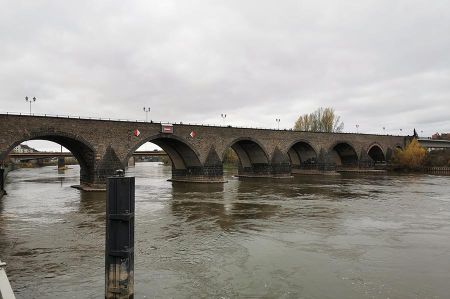Roman bridges over the Rhine and Moselle
- Written by Portal Editor
Our visit to the city of Koblenz also took us to the Balduin Bridge, a stone arch bridge over the Moselle that is considered the oldest surviving bridge in the city. The first construction of the Baldwin Bridge began under Elector Baldwin of Luxembourg around 1342/1343.
A document he issued about the start of bridge construction dates from May 1, 1343. On June 28, 1359, Archbishop Boemund II of Saarbrücken granted the right to charge bridge fees. The construction work on the bridge took around 85 years. With the construction of the gate tower in 1429, the bridge was finally completed.
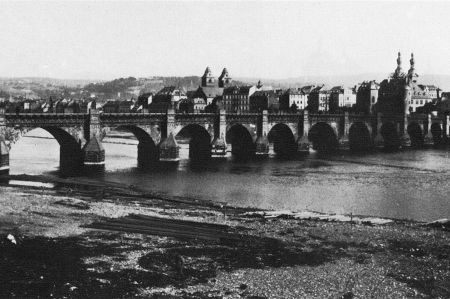 The Pope in Rome repeatedly granted indulgences to finance the construction of the bridge, which posed a great technical and financial challenge; The support was justified by facilitating pilgrim traffic. The foundations for the bridge formed their own assets, which were managed by their own bridge master until the end of the Electorate of Trier and secured the necessary funds for the maintenance of the bridge. The stone parapet wall bore a statue of St. John Nepomuk, the patron saint of bridges. At least temporarily, there were also small houses on the bridge or its pillars in which Jewish citizens lived Otto Kilger (Royal Court Photographer, 1842-1914) - Koblenz City Archives).
The Pope in Rome repeatedly granted indulgences to finance the construction of the bridge, which posed a great technical and financial challenge; The support was justified by facilitating pilgrim traffic. The foundations for the bridge formed their own assets, which were managed by their own bridge master until the end of the Electorate of Trier and secured the necessary funds for the maintenance of the bridge. The stone parapet wall bore a statue of St. John Nepomuk, the patron saint of bridges. At least temporarily, there were also small houses on the bridge or its pillars in which Jewish citizens lived Otto Kilger (Royal Court Photographer, 1842-1914) - Koblenz City Archives).
The Romans already had a bridge over the Moselle
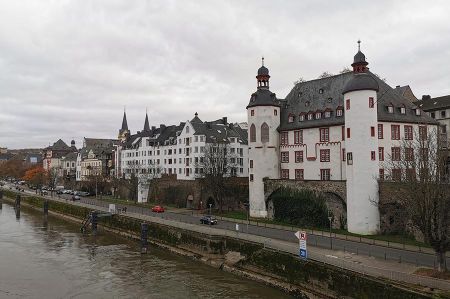 Long before the Balduin Bridge, there was a Moselle crossing in almost the same place and also a Rhine crossing near the Deutsches Eck. Roman bridges in Koblenz were built over both rivers after the “Confluentes” branch was founded. They were pile bridges and were destroyed at the latest when the Roman troops withdrew in the 5th century. The Rhine Bridge made it possible to support the Roman troops on the right bank of the Rhine and the Moselle Bridge was part of the Roman Rhine Valley Road. Between 1860 and 1867, the remains of a pile bridge from Roman times were discovered just 50 meters downstream next to the Balduin Bridge, which was probably part of the Roman Rhine Valley Road.
Long before the Balduin Bridge, there was a Moselle crossing in almost the same place and also a Rhine crossing near the Deutsches Eck. Roman bridges in Koblenz were built over both rivers after the “Confluentes” branch was founded. They were pile bridges and were destroyed at the latest when the Roman troops withdrew in the 5th century. The Rhine Bridge made it possible to support the Roman troops on the right bank of the Rhine and the Moselle Bridge was part of the Roman Rhine Valley Road. Between 1860 and 1867, the remains of a pile bridge from Roman times were discovered just 50 meters downstream next to the Balduin Bridge, which was probably part of the Roman Rhine Valley Road.
Roman pile bridge over the Moselle
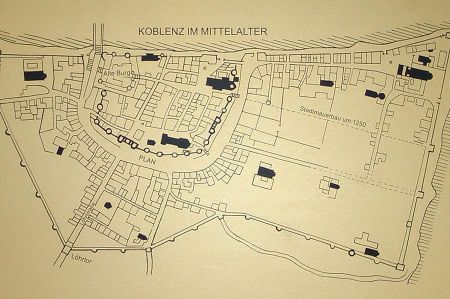 However, the exact construction time for a pile bridge over the Moselle could not be determined. Coin finds from the time of Claudius Gothicus (268–270) to Arcadius (395–408) are considered evidence that the bridge already existed in the 3rd century. During dredging work to expand the shipping channel in 1944 and to build the Koblenz barrage as part of the Moselle canalization from 1958 to 1964, numerous remains of the bridge were removed from the riverbed.
However, the exact construction time for a pile bridge over the Moselle could not be determined. Coin finds from the time of Claudius Gothicus (268–270) to Arcadius (395–408) are considered evidence that the bridge already existed in the 3rd century. During dredging work to expand the shipping channel in 1944 and to build the Koblenz barrage as part of the Moselle canalization from 1958 to 1964, numerous remains of the bridge were removed from the riverbed.
It is certain that the Koblenz auxiliary camp already existed around the middle of the 1st century, with the completion of the Roman Rhine Valley Road. The Koblenz earth fort served to secure this road and the river crossing over the Moselle. It can be assumed that the bridge over the Moselle already existed at that time. It is also certain that this pile bridge was destroyed when the Romans withdrew in the 5th century.
Until the Baldwin Bridge was built in the 14th century, there was no fixed crossing over the Moselle. A pile remnant of the Roman Moselle bridge is on display in the Moselle facilities near the Balduin Bridge.
Roman pile bridge also over the Rhine
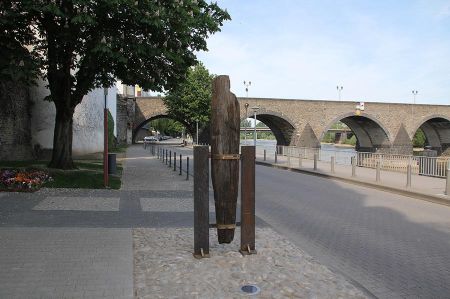 Very early on, based on various remains of piles found in the Rhine, the assumption arose that a bridge crossing had been built between Koblenz and Ehrenbreitstein in Roman times. The Kapuzinergrund, a former shoal in the Rhine at this point, seemed to be ideal for building a bridge. This shoal was leveled in the 19th century to improve the shipping channel. Wooden piles that had been driven into the Rhine floor were found and lifted. This collection of piles was the remains of a bridge yoke. The occasional speculation that this was Gaius Julius Caesar's Rhine bridge, which is located near Neuwied but has never been proven, is refuted by the specific constellation in which the wooden piles were arranged, as they do not fit into the traditional descriptions the Caesarian Rhine bridge fits.
Very early on, based on various remains of piles found in the Rhine, the assumption arose that a bridge crossing had been built between Koblenz and Ehrenbreitstein in Roman times. The Kapuzinergrund, a former shoal in the Rhine at this point, seemed to be ideal for building a bridge. This shoal was leveled in the 19th century to improve the shipping channel. Wooden piles that had been driven into the Rhine floor were found and lifted. This collection of piles was the remains of a bridge yoke. The occasional speculation that this was Gaius Julius Caesar's Rhine bridge, which is located near Neuwied but has never been proven, is refuted by the specific constellation in which the wooden piles were arranged, as they do not fit into the traditional descriptions the Caesarian Rhine bridge fits.
A pile shoe is a tapered steel cap of a pile that is driven into the ground for the deep foundation of buildings, especially for the foundation of bridges in riverbeds. According to numerous finds, the technique was already widespread in Roman bridge construction. To date, the basic shape of the conical attachments has changed little. The entirety of the foundation piles is called the pile grid.
Post shoes often have 4 tabs, each with a fastening hole for inserting a nail, the head of which should protrude as little as possible when driven in to make it easier to drive the post into the ground. Shown is an embodiment with 2 tabs, each of which has 2 holes. The tip of the pile shoe is sometimes a hollow pyramid into which the tip of the pile engages in a form-fitting manner.
Pile shoes can be made from steel rods by forging, with the hollow tip formed on the horn of an anvil.
In the 1st century there were military conflicts between Germanic tribes and the Romans. For this reason, many troops were brought together in the Roman auxiliary camp in Koblenz. The exact time when the bridge was built is unclear, but it was probably built to supply troops on the right bank of the Rhine.
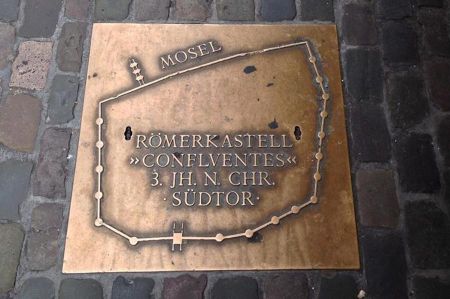 The Rhine bridge was 350-370 m long, 8.5 m high and was built from oak trunks. Around 650-750 logs were needed to build the bridge. The piles in the Rhine floor were equipped with iron tips, so-called pile shoes. 51 of these piles are still preserved today. The felling date of the oak trunks could be dated to the year 49 AD.
The Rhine bridge was 350-370 m long, 8.5 m high and was built from oak trunks. Around 650-750 logs were needed to build the bridge. The piles in the Rhine floor were equipped with iron tips, so-called pile shoes. 51 of these piles are still preserved today. The felling date of the oak trunks could be dated to the year 49 AD.
After the Limes was completely expanded in the 2nd century, the pile bridge over the Rhine lost its importance. It is not known exactly when the bridge was finally abandoned. However, it was probably destroyed when the Limes and the Niederberg fort were abandoned in the 3rd century.
Please read as well:
